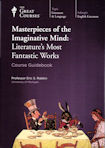This is the course guidebook that accompanies the 24 lecture “Great Course” of the same name. It is essentially an abbreviated transcript of each lecture, some related reading, and some “questions to consider”. (I watched the lectures, which is what I am reviewing here, and am using the book simply as an aide-memoire.)
Rabkin discusses a broad range of literature on the spectrum of the fantastic, covering fairy tales, magical realism, fantasy, experimental fiction, and science fiction. He starts with an historical approach, looking at the work of the Grimm brothers and the tales of Hoffmann. He covers theory, such as Propp’s work on the structure of fairy tales, and various Freudian ideas used by writers.
He moves on to an important sub-branch of the fantastic: science fiction, which he appears to be more passionate about, from his lecturing style. Science fiction, he says, can be seen as part of a tradition: from the Gothic, to Ann Radcliffe’s “Scooby-Doo ending” Gothic style that ends with an explanation, to Frankenstein and its ilk with the explanation moved to the beginning. This leads to his definition of SF, which I rather like: the fantastic made plausible against a background of science; that is, the fantastic elements have an explanation, and that explanation relies on science, rather than magic, or some other feature.
There’s what I feel to be over-interpretation in places. For example, one of the books Rabkin discusses has two characters called simply A and D; “Anno domini?” he wonders. But we could play a similar game with any two letters chosen. There is a lot of discussion of the relation to certain myths, and he introduces his construction of “the Eden complex” as an analytical device (no, this has nothing to do with the Eden Project). The complex is used to structure some SFnal plots in terms of: garden (of Eden) and vegetative imagery, fairy tale aesthetics, “some things man is not meant to know”, a scientist playing god, an Oedipal conflict or comedy between the generations, and dichotomies such as nature v science and spirit v flesh. He points out example tales that exhibit these aspects, and claims that much SF employs the Eden complex. However, he also says that if only part of the complex is actually present, all of it is potentially present, which is a somewhat convenient stance to take to support the claim.
All in all, a lot of food for thought, and interesting perspectives and insights, but maybe a tad over-analysed in places.
